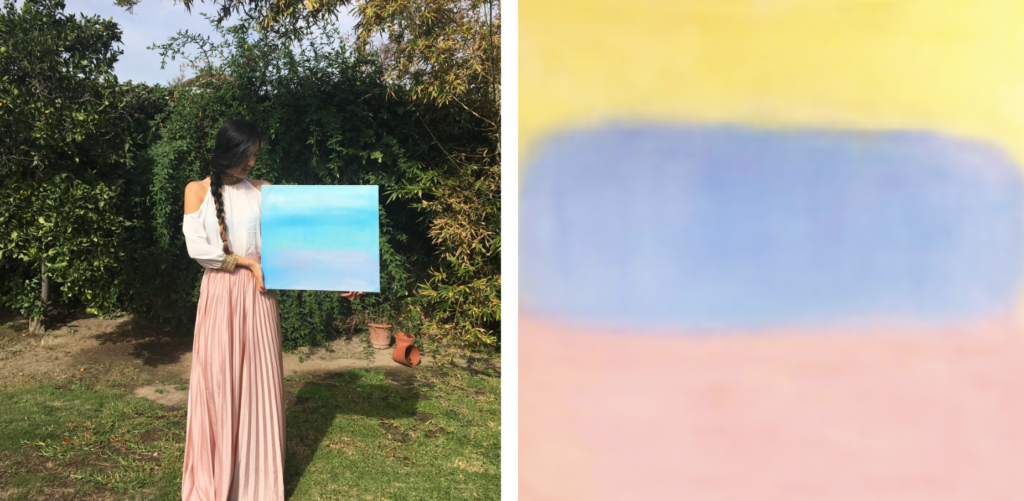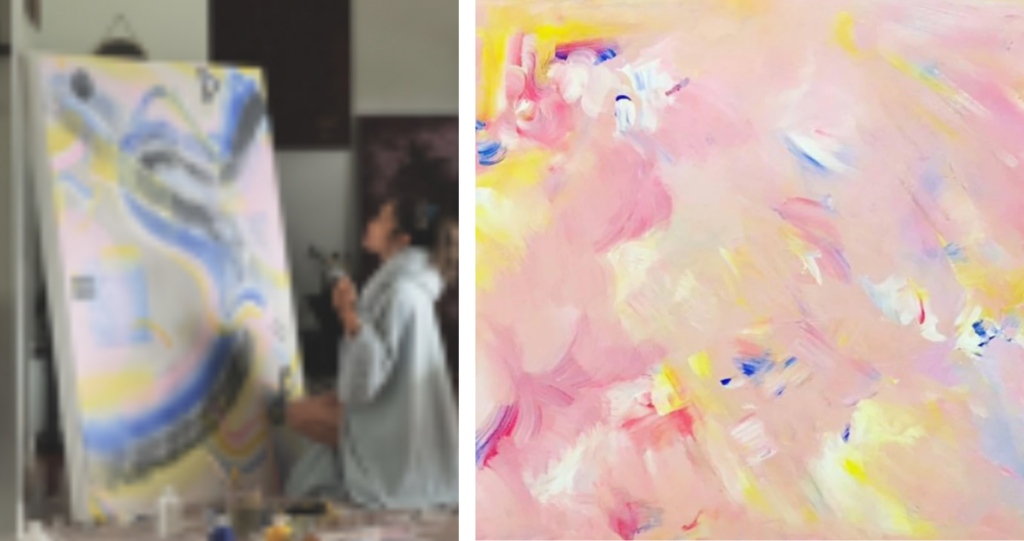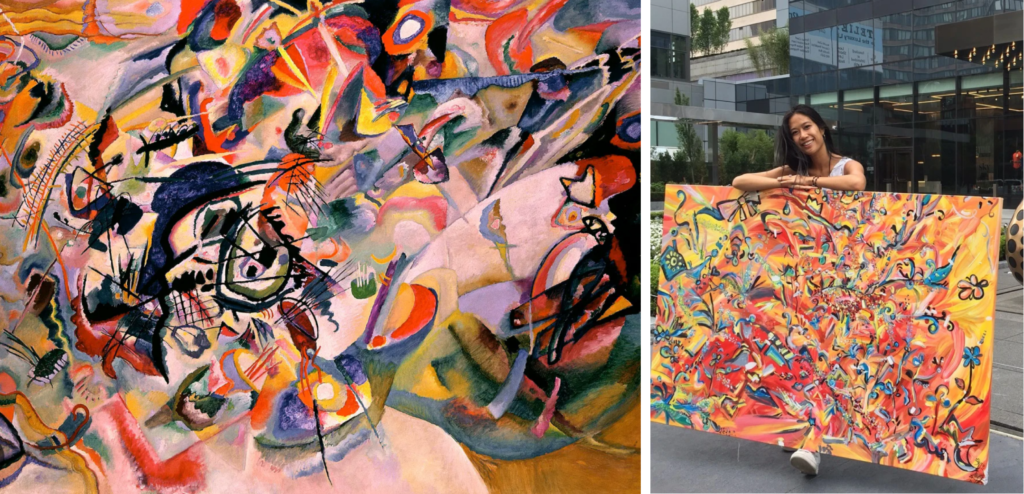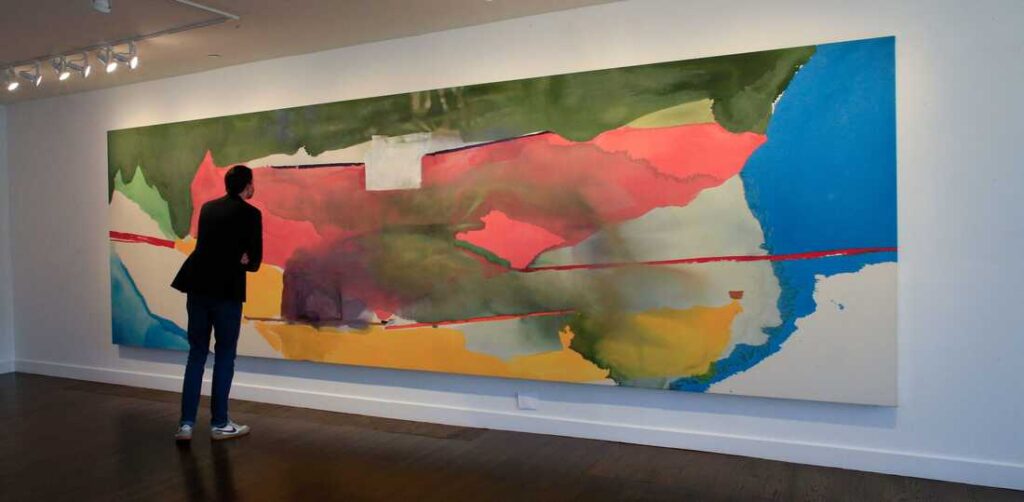
Bibi: I’ll start by saying I think all human beings are artists at heart first and foremost, especially children. I teach art to children. My mom is really deep in art even though she is trained in law. She raised me with handmade cards and drawings. I always had an interest in it. Art in a way was a form of an escape for me. I would lose myself in certain shows. The anime Sailor Moon became a form of art because I would sit and draw hundreds of pages of these figures and their outfits. I was fascinated that each character had a color scheme and cosmic planetary association to them. I started really early with drawing. I studied art in high school and even though I went to a traditional liberal arts college at Duke University, I fell into an art class and it was my best class. I switched my major to art and ended up studying printmaking and painting abroad in Buenos Aires. Painting is what stuck with me.

Bibi: The era when I was younger I did not have a process. In my mid-twenties I started falling in love with the abstract expressionist movement and Mark Rothko’s work. He just dove into the raw experience of color. How can you make a person feel what it means to be inside of red. That’s what I feel his works do. I went into a phase where it was about that – the pure experience of color.

Bibi: Now I’m working on a series where the process is more methodical. In these works I am processing my relationships through symbolism and color metaphor. I identify what colors I associate with the connection; red could be for anger, or passion; purple for transcendence, or comfort. It’s up to interpretation per connection.. I start by painting one layer and going over it in white, like a rewriting of history from past to present. Then I paint a symbol or invent a hieroglyph representing that connection; it is my way of processing it from a perspective of stepping back. Then I paint over it with colors to channel it. Each piece is about a person or energy that has had an impact in my life.

Bibi: I realize so much of our life is relationships with other people and how those play into our relationship with ourself. We are constantly discovering ourself while also losing ourself through others.
Bibi: I’ve had many friends ask me that! I didn’t say it, you said it!!! I feel like the best way to memorialize something that caused confusion and tension in the past is to romanticize or memorialize it by making art about it. Thank god for art. Right now in my phase I’m leaving behind that identity of self with (an)other. Now it’s about self with self or self with universe. Self with something greater than self – higher self, which inadvertently has to leave behind these old relationships. The ten pieces I’m creating right now represent the ways I’ve had of relating over the years with specific individuals.
Bibi: I can look at these and smile to myself that I’m not holding onto that anymore. That’s the beauty of it. It’s a soul purge, an energetic transmutation.

Bibi: From a visual place I get inspired. Palette is a thing. When I was in Italy I was inspired. There was so much beige and the light pinks and the Mediterranean ocean. It was Puglia where I was, I couldn’t wait to get back and paint. A lot of my travel has been spiritually oriented. It is not only the visual but how it changes me as a human. That also translates into the art. Every country and place is a form of inspiration. From the colors, the smells, the flavors, the accents, architecture and music and history; traveling allows me to be a membrane or sponge and absorb all that vibrancy into my being.
Bibi: There is another form of knowledge in India that has to do with color from the chakras and reiki. Chakras first stemmed from the Veda, sacred spiritual texts from 1000 BC. They are the energy points in our body. Each chakra is a color. The color is associated with a way of being. Red is associated with stability. Yellow is associated with power and self-confidence. Green, with the heart, Blue with the seed of intuition or third eye; Violet, with our connection to divine spirit. What I pulled from India is that piece of knowledge which now translates to how I think about color in my outfits and my paintings.

Bibi: If I could be born in any era it would be that of abstract expressionism. The artists then used the art to channel the unseen. From that time Helen Frankenthaler has beautiful huge paintings of abstract color that transcend beyond the physical moment into something deeper. Kandinsky was amazing for the way he married the senses. I feel that when I hear music there are certain colors that go with ways of expressing lines. He used that synesthesia through his art. I have a friend Chris Watts who has experimental ways to create canvas. He is very deep in his research. Recently he traveled to South American to get plants a create pigments from scratch for his paintings. In terms of dedication to process I admire him.

Bibi: There is one that brings me the most tranquility, which I keep in my own home. It is a large piece composed of a baby yellow, a baby pink, and a baby blue. A simple painting I made that was free from everything – it was something for me. I wasn’t trying to push a style on myself. It was pure from me.

Bibi: There was a piece I made when I was really really sad. I was in a really bad place and I had to get the colors out. A friend had asked about it and I thought “oooooo I shouldn’t tell him the story, it’s so negative”. Why would someone want this? I told him I felt so devastated by something that had happened it was like death had to come out of me. That’s when I made this. You probably don’t want it. It’s negative. He said “I love it! I want it!” He wanted the drama.
Bibi: A couple months ago it would be about the balance. I’ve been catering my style to the ideas of others for years now. I’ve made a commitment coming out of this phase that I will stop doing that. Right now, I’m painting for myself. I don’t know if this will sound rude, but right now I don’t really care. I want the work to be pure from me and it will attract what it’s meant to attract.
Don’t miss our future updates! Get Subscribed Today!
© 2025 Creativo Consolidated, All Rights Reserved.